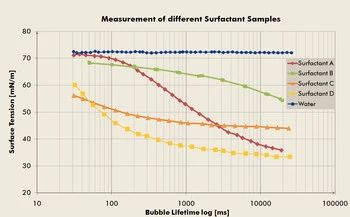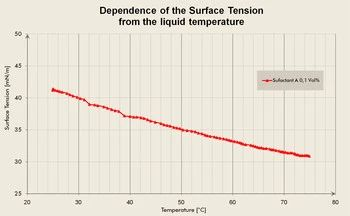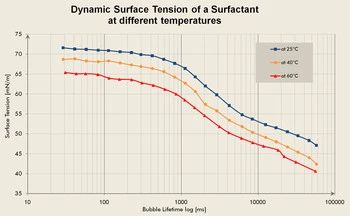Our main products: Amino silicone, block silicone, hydrophilic silicone,all of their silicone emulsion,wetting rubbing fastness improver, water repellent(Fluorine free,Carbon 6,Carbon 8), demin washing chemicals(ABS, Enzyme, Spandex protector, Manganese remover), Main export countries: India, Pakistan, Bangladesh, Türkiye, Indonesia, Uzbekistan, etc
The dynamic behavior of surfactants affecting surface tension.
The surface tension of surfactants exhibits different kinetic behaviors, which depend not only on concentration and temperature, but also on the type or mixture of surfactants. The surface tension of certain surfactants decreases very rapidly at the beginning, and then decreases more slowly according to surface time. On the contrary, the decrease in surface tension of other surfactants is more constant and almost linear.

This figure shows different surface tension curves. The dynamic behavior required for surfactants depends on the application field. According to the figure below, surfactants C and D are the best choices for dynamic processes because they significantly reduce surface tension from the beginning. Suggest using surfactants A and B for non dynamic tasks.
The effect of surfactants on surface tension depends on temperature.

The surface tension of liquids and the effect of surfactants on surface tension depend on temperature. In addition, due to the higher thermal energy, the dynamics of surfactant molecules increase. Usually, surface tension decreases with increasing temperature. As a result, the characteristics of liquids containing surfactants are significantly affected by temperature changes. Depending on the product, temperature effects may have a positive or negative impact on the desired characteristics. To prevent negative changes, other surfactants or diluted solutions must be added separately.

Anyway, it is very important to understand how surface tension is affected by temperature changes.
At a certain temperature, non-ionic surfactants in water are no longer soluble and form phases with a large amount of surfactants. Due to these droplets, the solution becomes turbid. The characteristic of non-ionic surfactants is a specific temperature point called the cloud point or phase transition temperature. The closer the cleaning efficiency of non-ionic surfactants and surfactant systems is to the process cloud point, the better the cleanliness can be improved. Appropriate additives can be used to adjust the cloud point according to the desired operating temperature.

A tension meter can easily analyze such temperature dependencies in research and development, as well as product or process optimization.
By adjusting the surface lifetime, more precisely, the bubble lifetime, to a fixed value, surface tension can be permanently measured with temperature changes. Therefore, the influence of surface aging (liquid air interface) on surface tension can be ignored. This enables continuous measurement of the effect of temperature on surfactant solutions with constant parameters.
A double-layer glass container with hot liquid circulation can automatically measure the change in surface tension relative to temperature. Therefore, the test results provide valuable information for research and development to ensure the optimal application of the product in the corresponding application field.
Post time: Oct-11-2024

